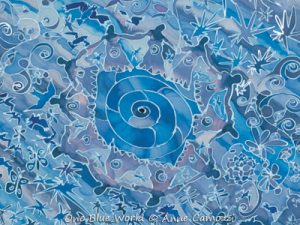Spirited Reflection: One blue world – art & healing

In this Earth Day reflection I explore environment, art and healing. The image of my painting One Blue World (2004), was a prayer for water. The 2003 Iraq war was in the news everyday as I started painting. I couldn’t reconcile the wonder Nature evoked in me, with acts of war, especially considering we’re just a tiny blue dot in a huge universe, where geo-political boundaries disappear. As I painted, I thought about water, knowing we can live about a month without food, but only a week without water. And, though about 71% of Earth is water, 97% is salty or frozen, leaving very little to meet our needs. And of what’s left, we often waste, poison or manipulate it.
But that’s not what I wanted to paint; I wanted to explore the reverence and gratitude I felt for water, trying as poet Rilke wrote in his Book of Hours, to let Creator energy “flow through me like a river.” And as I painted, a story emerged. The many blues of water, a sacred spiral shell, people dancing, birds, butterflies, dragonflies, swirling around them. It’s a small act, one painting, but a creative act, for I believe it’s creativity that’s needed for healing.
Earth Day
This year the official Earth Day campaign centers on environmental literacy. Their website states “education is the foundation for progress” and there is a need for “a global citizenry fluent in the concepts of climate change” and “its unprecedented threat to our planet.” As a lifelong environmental educator, I believe we all have a role to play to advance the notion of literate environmental citizens, be it water, climate change, or other socio-economic corners of the sustainability triangle. But even the Earth Day website gets it slightly wrong, for it’s human life that’s our greatest concern. Unless a meteorite explodes the Earth, or we lose the sun’s energy, our planet will survive; it’s humans and other species in peril.
Over 25 years ago, Green Plans and action projects were developed, including an Environment Canada document promoting environmental literacy. Yet, today, instead of a more literate society, there’s increasing confusion and many, especially young people, feel disempowered, overwhelmed and cynical. It’s not surprising when words like threat and doom are commonly used. “Eco-anxiety”, a new term to describe excessive anxious thoughts about our future, has spawned eco-therapists. While I support people getting help, I believe eco-anxiety could be avoided if messaging about the future offered opportunities for creative expression and concrete actions. This is where art becomes important, promoting actions to heal and protect our home; this tiny blue dot we live on.
I use “art” in the broadest sense. All too often people say, “I can’t do art.” Actually everyone is creative in some way, and in each of us is the capacity to help with eco-healing. Creativity can be visual arts, dance, music, theatre, stories, gardens, hospitality, whatever actions make your heart sing. Creativity is tapping into the joy that springs from your innermost self, from the Creator in all of us – source energy – some name it.
As an artist and author, I try to respond to Picasso who asked, “What do you think an artist is? An imbecile who only has eyes, if he is a painter, or ears if he is a musician?…he is also a political being, constantly aware of the heartbreaking, passionate, or delightful things that happen in the world, shaping himself completely in their image. How could it be possible to feel no interest in other people, and with a cool indifference to detach yourself from the very life which they bring to you so abundantly? No, painting is not done to decorate apartments. It is an instrument of war.”
So it’s different approaches we need, using the arts to help educate and encourage action. One of the reasons creativity works is that personal healing often happens when we tap into our creative centres. Science says creating helps with pain, mood, many medical conditions, and also enhances satisfaction, making people more hopeful. Just looking at art can mean a person needs less pain medication.
Perhaps the approach of our First Nations neighbours, who use their cultural and artistic traditions and stories to promote healing, as well as awareness, might help guide our efforts to heal ourselves and our planet.
We can’t wish for the younger generation, or anyone, to have the capacity to act if we overpower them with “threats” in this urgent need for literacy. Let’s ensure that environmental education embraces arts, harnesses creativity and explores passion, play, awe, and reverence.
Anne Camozzi is an artist & author from St. James United Church Social Justice Committee, Antigonish, Nova Scotia. www.annecamozzi.com




